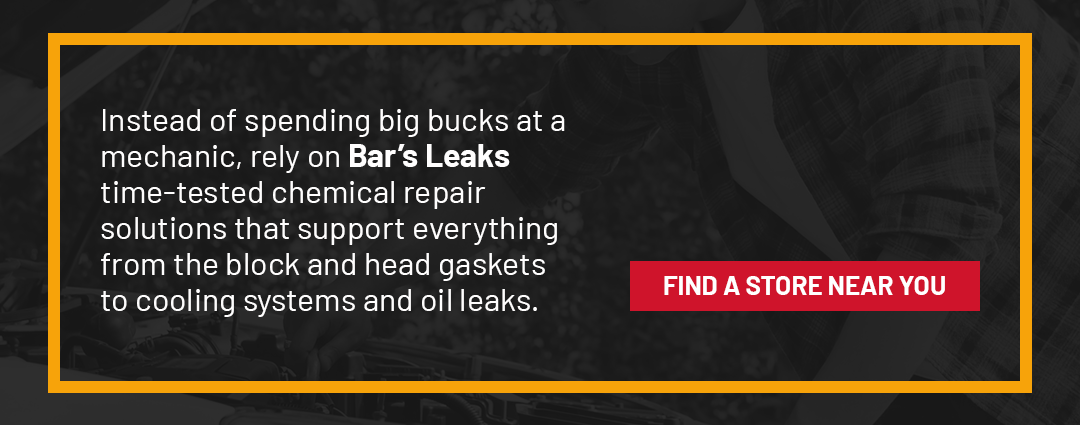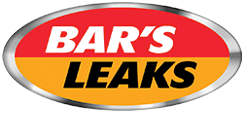Investing in a car is an exciting venture, no matter if it’s your first set of wheels or your fifth time around the block. If you’re looking to buy a used vehicle, you don’t need to be an auto expert. The best thing you can do is prepare yourself with knowledge before diving into a significant deal. A pre-owned car won’t be in perfect condition like it came from the production line, but it shouldn’t be dragging its tailpipe either.
Bar’s Leaks can help you understand the difference between fixable repairs and total busts when it comes to purchasing a used car. Finding what you need centers around detailed research and thorough inspections before making a verdict. Follow our guide to learn more about how to check a used car by spotting potential damages.

Investing in New vs. Used Cars
It’s the ultimate question — is buying new or used a better option? While there is no right or wrong answer, each has its benefits and downfalls depending on your finances and application. A new vehicle will give you a fresh car off the lot with a working engine, excellent tires and comfortable interior but at a massive upfront cost.
A used car, however, is an excellent option for a quality vehicle at a more reasonable price — and you can often receive one that operates as well as a new make and model. Driving a used car is no less safe than operating a new version unless you choose one with a failing engine and bad tires. There is a line between purchasing a botched and reliable used car.
Are There Laws Protecting Used-Car Sales?
Consumer protection laws, also known as lemon laws, are a set of stipulations that entitle you to a refund or replacement when your purchase is either damaged or faulty. Yet, they don’t give you the green light not to research used cars. Lemon laws don’t often apply to all used car sales. While the law requires the retailer to have warranties that are clear and easy-to-read, they are not an actual prerequisite.
It’s smart to partner with a retailer that has a warranty for their used vehicles because if they do, you’ll likely benefit from the consumer protection law. Since car dealers are not required to have a guarantee, they can make the purchasing process a bit challenging.
Depending on where you live, different states uphold varying used-car regulations. You can find out how your state protects you by referencing your state’s lemon laws. Some state consumer protection laws apply to dealerships but not private vehicle sellers.
A Used Car Buying Checklist
The first step you want to take when putting money into a used car is identifying a variety of makes and models that have high-reliability rates. You will also want to review the window sticker of any used car. According to the Federal Trade Commission, the vehicle dealer must provide a Buyer’s Guide in every offered vehicle with information like whether the engine has a warranty or if it’s being sold “as is.”
The sticker should also illustrate whether the dealer is paying a percentage of the repair costs. If you make changes during the negotiation, the dealer must alter the guide. An “as is” vehicle means the person selling the car doesn’t guarantee its condition — making you responsible for any issues that arise.
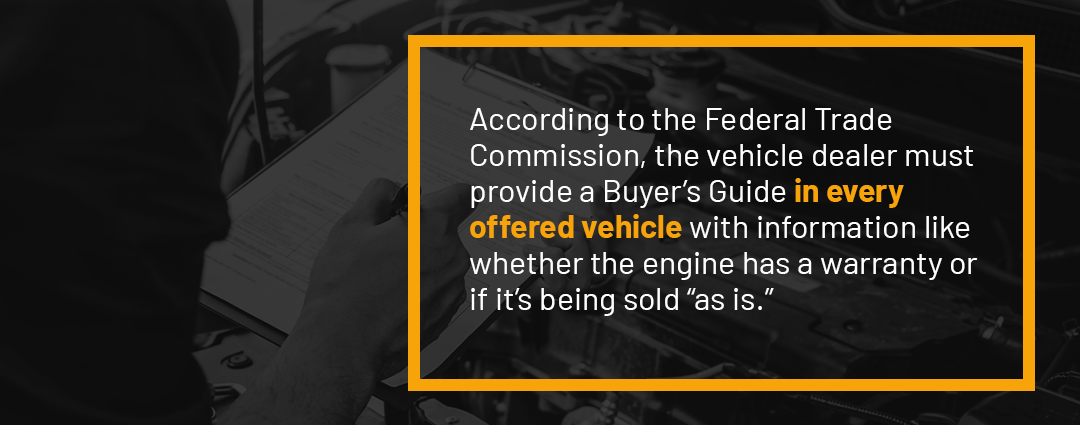
Things to look for when buying a used car comes down to obvious “good” or “bad” indications. If the vehicle you’re looking at feels, looks or sounds sketchy, it probably is. The trick when checking a used car is knowing how to differentiate between the minor and major faults.
Bar’s Leaks devised a comprehensive checklist to give you insight on what to look for when buying a used car. From the vehicle’s history and test drives to interior, exterior and hood inspections, you’ll know what to search for.
Consider the Car’s History
Before you begin the inspection process, ask the dealer or private seller for the service history report of the used vehicle. The information can tell you about the car’s repairs, performance and problems. It’s ideal for the previous owner to have a maintenance and service record.
Some sellers may not have documentation because they performed maintenance at home. You can then ask for receipts to ensure when they bought the new parts and if the repairs are legitimate. There can be times when you’re looking at a car that’s been in an accident, so it’s crucial to receive as must history as possible.
You can also inquire about the car’s previous application. Did the last owner use the vehicle for periodic trips, everyday use or to get them through harsh conditions? You should also keep a record of your documents when buying from a private seller. Bring a notebook to write down any damages you see when making an inspection that will necessitate future repairs.
Inspect the Outside of the Vehicle
As soon as you arrive at the dealership or private appointment, you’ll want to take a look at the exterior parts of the car. Begin by making sure it’s on level ground with the emergency brake issued before ushering any inspections.
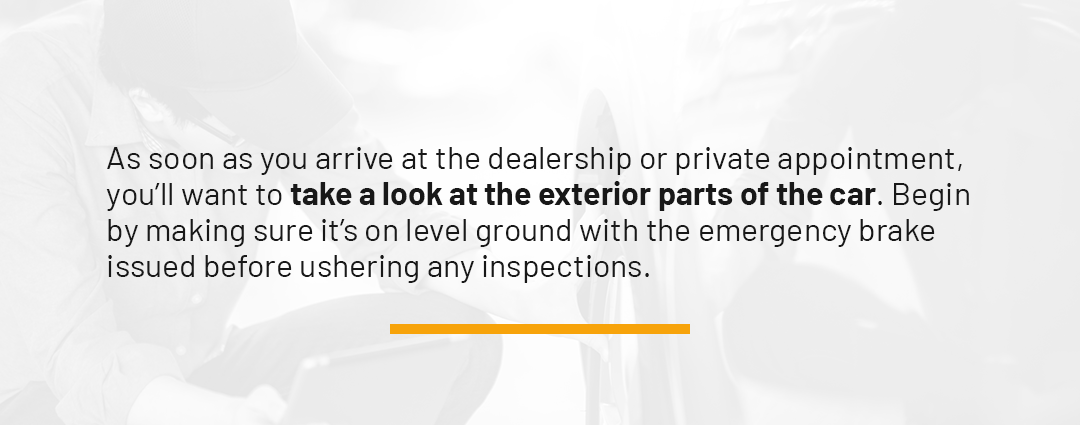
As a safety and inspection tip, you don’t want to see a car in the dark or under lights because faults can be hidden. Make sure you’re partnering with a reputable dealership. If working with a private seller, meet them at a public location during the day.
Investigate the external components like tires, glass, paint job, frame, suspension, body panels and roof.
1. Tires
Uneven tread wear is a bad sign for any of the four tires. The tires should have at least 1/16-inch treads. You can check the depth of a tire’s tread by using a quarter. Place the quarter in the tread with the head down. If you can still see it, then the tire needs replacing.
Take your time inspecting each one for feathering. When one side of the tire is more worn than the other, it can relate to faulty alignment. Poor alignment is then a result of a worn suspension or damaged car frame, which can affect the vehicle’s performance. It’s possible to suffer from a driving hazard when the tires have little to no tread or are misaligned.
Underinflated tires will wear more on the outside, while overinflated rubber will erode in the middle. Tires worn unevenly at the circumference of the tread can show problems with the steering, brakes or suspension. If you see heavier wear on the outside shoulder of a tire, it can often confirm heavier use.
While inspecting the tires, study the rims for cracks and dents along with the sidewalls for bulges and scuffing. Do the wheel wells have rust? You’ll also want to check that all four tires are the same — otherwise, one or more could have been replaced. Ask whether the tires were rotated regularly and if a spare tire is available.
2. Glass
You may not think of glass as being a vital component to consider, but you should look for cracks and pocketed areas. If there are any nicks in the front or back windshields, they can worsen over time, jeopardizing your safety.
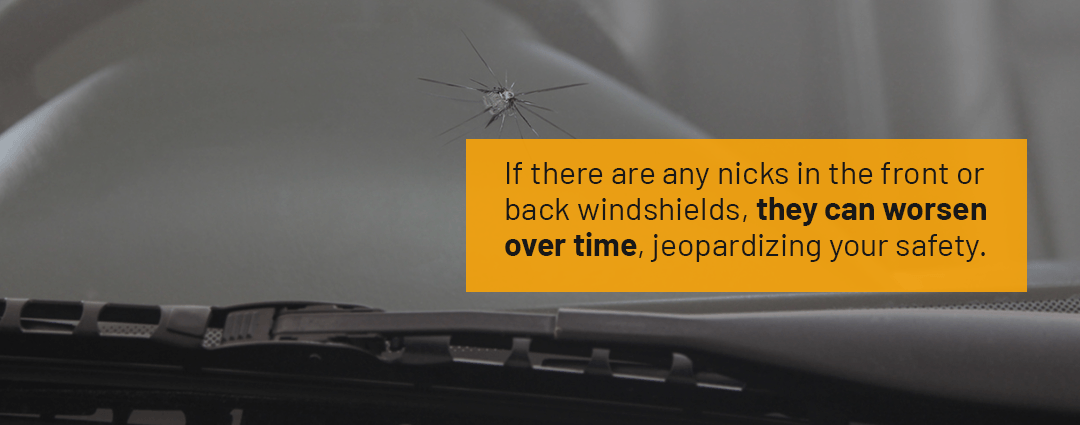
3. Paint Job
Although the physical appearance of a car doesn’t affect a vehicle’s performance levels, it can affect how much you pay. Look for rust, corrosion, scratches and dents in the paint. If the car isn’t clean, dirt and other contaminants can hide possible abrasions. Inspect the sides of the vehicle from each end. If you notice waviness in the paint, it can indicate a bad paint job. You can also run your fingers along the panel joints for roughness.
4. Frame
Any noticeable frame damage can shorten the lifespan of a car. Even if you see repaired sections, it’s more likely to break down compared to a sturdier frame. Check the undercarriage where the piece attaches to the front fenders while supporting the radiator top. The frame can either be bolted or welded together. Examine the bolts inside the hood at the top of the fenders. Replaced fenders can indicate a car collision.
5. Body Panels and Roof
At first glance, you may see a nice car, but when you pay more close attention, you can see the small details. Look for rust, dents and scratches in the side panels and roof of the car. Are the fenders and doors aligned?
Use a magnet to tell where body filler is present on the body panels. It won’t adhere to areas that have been patched up. Scrutinize the rocker panels and door bottoms for excessive rust. Even check the opening and closing of the doors and review for degraded rubber seals.
6. Suspension
Check the car’s suspension by pressing on each corner of the vehicle. It will show you the reliability of the shock absorbers. If they are in good shape, the car will bounce back up. If the ends continue to move up and down, it’s not a good sign.
You can also tug at each front tire to examine how the suspension joints and bearings hold up. Any noises may indicate bad bearings.
Scanning the outside of the used car is an excellent starting point when determining whether it’s a good or bad buy. Ask questions as you go to ensure you’re receiving the most critical information.
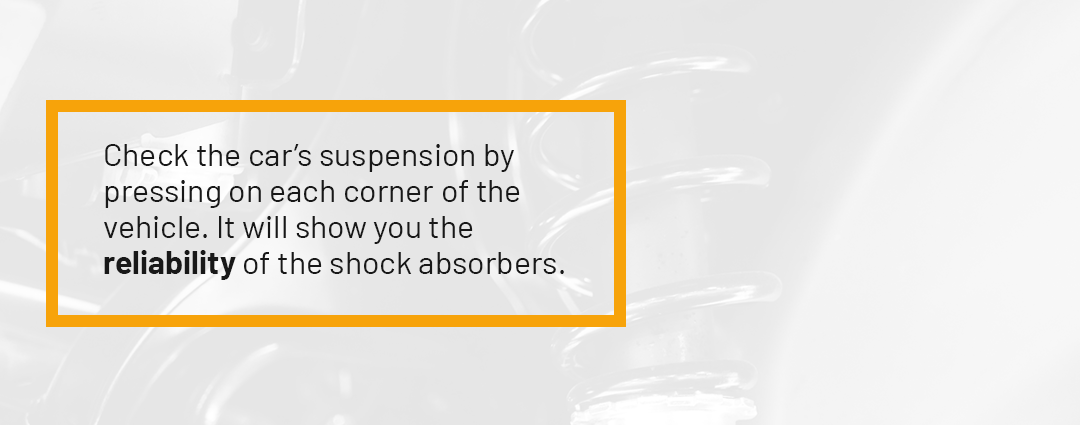
Check the Car’s Inside Components
Looking for the right used car doesn’t mean you have to restrict yourself to examining the exterior portions of a vehicle. Sometimes sitting inside can help you gain more insight and get the best feel.
1. Odometer
Checking the car’s mileage is one of the most vital parts of inspecting a used car. The number of miles a vehicle has performed can specify its age and performance. The average miles a car drives each year is about 10,000 to 15,000.
Cars age and wear out over time and mileage. Yet, be careful of odometer readings. A 15-year-old car with low mileage doesn’t mean it’s in excellent condition. Conversely, a newer version could have high mileage, but the previous owner kept up with maintenance and made repairs. Inspect the odometer to see if it matches the condition of the car and, if not, whether it’s positive or negative.

2. Trunk
Investigate the inside of the trunk for cracks, rust, wear, water damage and holes. Does the trunk open with ease and shut securely? Any minor damage can mean a quick fix but more serious cracks and rust can affect the integrity of the car and trunk or indicate water leakage.
3. Heat and Air Conditioning
Imagine buying a car that doesn’t have AC in the dead of summer or heat when the windshield freezes over. Ensure both elements work by testing the temperatures as well as the fan speed. Ask about the refrigerant and when it’s last been filled. Does the refrigerant leak?
4. Display and Indicator Lights
Make sure turn signals and hazard lights work. Turn the key without starting the car, and all the warning lights should illuminate. Have a second person or the dealer turn on different indicators as you check outside the vehicle. Make sure all switches and buttons work.
Do the error and sensor alerts work? Does the car nicely idle once you start the engine, or does it need engine solutions? If available, you can also check that the backup camera and radio operate well.
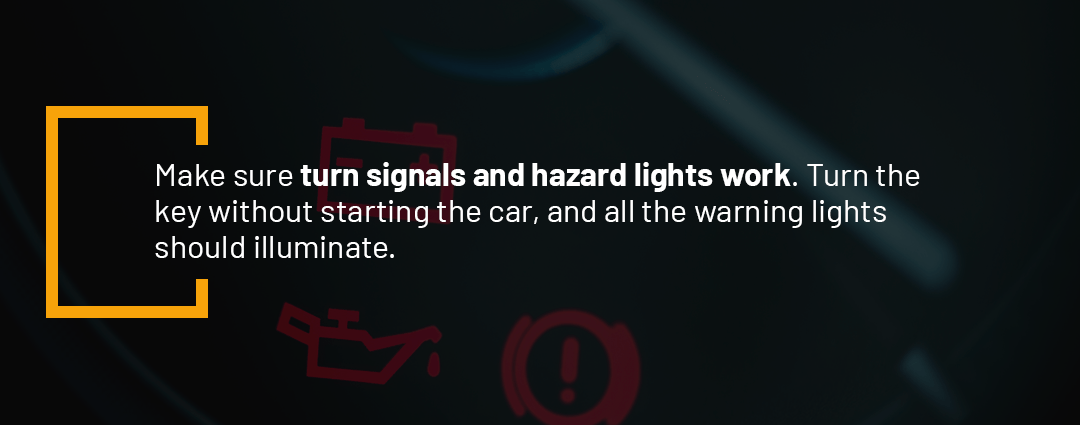
5. Upholstery
If you’re going to be riding in the car, you may as well make sure it’s comfortable. Are the seats tattered and worn? Are there any tears, rips, holes or stains in the upholstery? What about the adjustable seats? Is there a musty smell to the interior?
Examining the upholstery for damage can relate to hard use and may require repairs. The smell of mold or mildew can be a result of water leaks. Inquire about water damage and check under the floor mats for wet spots. Some smells can come from smoke can be tricky to get rid of too.
Look at the rubber application on the brake, gas and clutch pedals. The amount of wear on the rubber can show how much use the car has had. What about the roof trim and headliner? Check for sags and stains that express water leakage from the sunroof, windows or doors.
6. Computer Code Reader
If the pre-owned car has a computer code reader, you can plug the device in to check for any errors. It will show warnings when you start the car.
The inside of any used car can tell you a lot about how the previous owner kept the vehicle.
Take a Look Under the Hood
Wait until the engine is cool to inspect for damage. Look for cracks, dents, rust and obvious mishaps that can illustrate a sign of poor or no maintenance that can relate to the safety of the car. Does the hood open easily and remain stable when propped up?
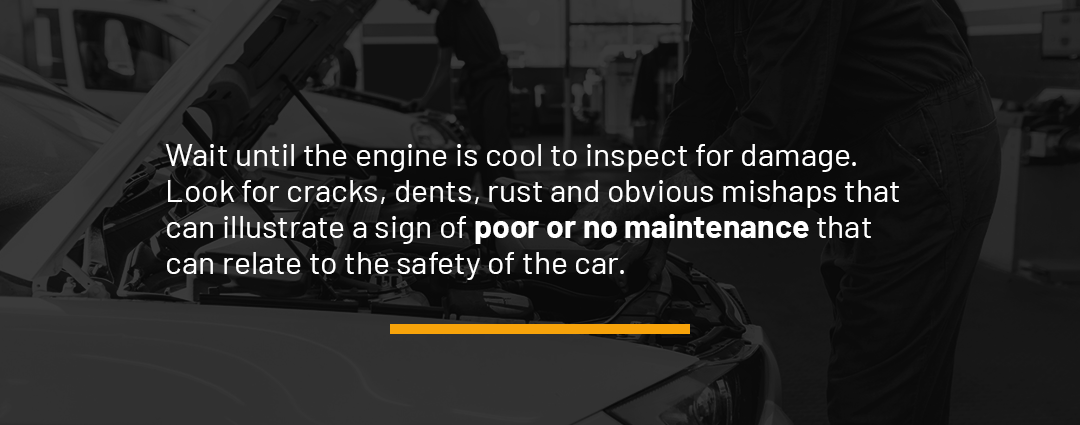
1. Hoses and Belts
Are the components fraying, cracked or discolored? Make sure the radiator hoses are not lax by squeezing them. They shouldn’t be hard or mushy, but an in-between feel. The radiator should have a green or orange coolant that’s not rusty or milky in color. You can see pinhole leaks in the radiator if stains occur on the outside of the component. You also don’t want the belt to snap once you turn the ignition.
2. Corrosion and Leaks in the Engine
Check a used car for leaks and the engine block for oil stains. If dark stains are apparent, they can be the result of a leaking gasket — which is expensive to repair or replace. Check to make sure all the fluid levels are up to par. If any tanks are empty, leaks may be present, whether it comes from the oil, gas, transmission or coolant fluid. You also don’t want to see oil leaks on the pavement or splatters throughout the engine.
3. Oil Cap and Oil
Unscrew the oil cap and see if it’s clean. If foam appears on the inside of the lid, or if water drops form on the stick, it can be a clear sign that the head gasket is leaking or the vehicle has a cracked engine block. Head gasket repairs are expensive and time-consuming unless you rely on our block and head gasket solutions. The oil should be dark in color and not gritty.
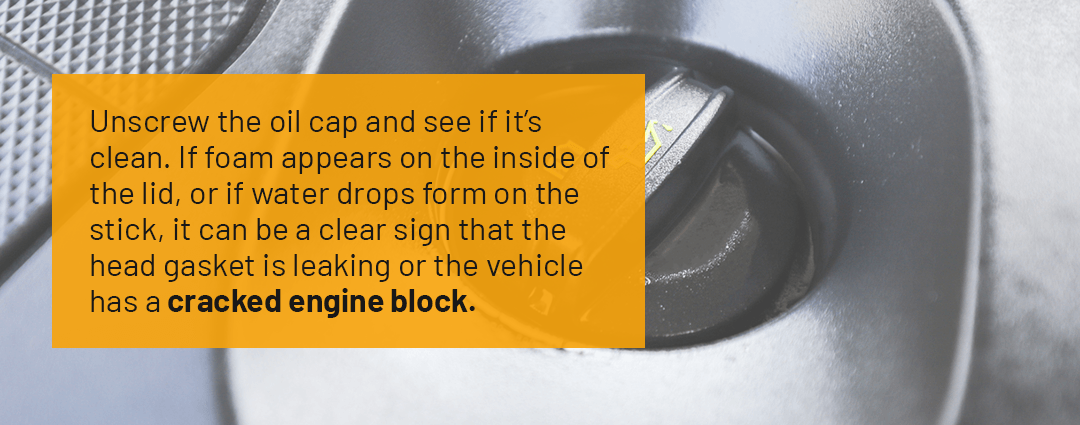
4. Transmission Fluid and Power Steering Fluid
Take a look at the transmission fluid by pulling out the ring at the bottom of the stick. The liquid shouldn’t smell burnt and should appear red or pink, not brown. The transmission should also have topped-up fuel. Otherwise, there could be potential leaks. If the fuel is discolored or smells, it means there is seepage, or the transmission is experiencing failure. Also, check the brake and power steering fluid levels.
5. Battery
Corrosion is the culprit of many engine failures. You don’t want the car’s battery to have corrosion. Some have a charge indicator showing green as healthy and yellow or black for a dying battery. It may not give a proper reading of the entire unit, though. Wipe the battery and check the electrolyte level. A low level means it’s losing its charge.
6. Undercarriage and Exhaust System
Inspect the undercarriage and exhaust for rust. Any black spots located on the exhaust can indicate leaks and burnt oil. Check the frame for rust and damage, as well. While rust isn’t necessarily a deal-breaker, it does mean there is wear that can affect the price of a used car. When rust starts to form holes and cracks, however, the vehicle may need repairs. Dents in the exhaust are not good signs and may dissuade you from making the purchase.
Don’t be afraid to get dirty and take a look under the car to make sure you’re not missing critical information.
Take It for a Test Drive
One of the best ways to conclude whether a used car is a good investment or not is to take it for a test drive. It’s a tremendous opportunity for you to listen and feel for the condition of the car. Have the seller ride with you and ask questions as you go. Take a drive of different roads at varying speeds to learn how the vehicle operates through twists, turns and straightaways at low and high speeds. Does the transmission smoothly shift from one gear to the next?
1. Brakes
While driving, ensure the brakes work well by pressing down hard to make the car come to a complete halt. As you approach a stop sign, press down slowly to see if the brakes decelerate well. Make sure the car doesn’t slide or shift when pressing on the brakes. If the vehicle swerves, there can be an issue with the brake caliber or steering components.
Any vibration or noises from the brake pedal can be a bad sign as well. If the brake pulsates, it means it needs resurfaced rotors and new brake pads. Always practice safe driving techniques away from other cars.
2. Speed and Turns
As you conduct various turns and accelerations, does the car shake at different speeds? If so, it may indicate worn mechanical parts or uneven wear of the tires. Feel how the car turns on sharp and wide turns, keeping an ear out for clunking noises and other sounds.
3. Comfort
If the car meets all your requirements, it may come down to the final factor of comfort. Can you see yourself driving the vehicle for work, trips and daily errands? Do you feel safe, comfy and in high spirits about the investment? Take your time during the test drive and even practice things like parallel parking and reversing.
After you complete the test drive of the used car, you will have a better idea of how the vehicle operates when driven in different environments, turns and speeds.
Should You Have a Used Car Mechanical Check After Purchase?
Once people buy a used car, they often wonder if they should have a mechanic check the vehicle. While it’s a smart idea to refer to the professionals after a new purchase, it may be even more beneficial to do so during the test drive if allowed.
You can take the car, truck or SUV to a repair shop where a mechanic can inspect the entire vehicle. The average price is about $100. The mechanic will provide a written report with details of the car’s condition. Have them note any problems or failures along with the cost of needed repairs.
You can use the report to negotiate a final deal. You can also rely on the support of someone you trust who has exceptional vehicle knowledge. They can help you inspect the engine components and undercarriage throughout the inspection process. Or, you can hire a third party when you meet the dealer for guided expertise.
No matter if you choose a professional mechanic or friend during or after the assessment period, they can help clarify how the used car operates.
Negotiating a Good Price
You can always negotiate the price of a used car with a dealer or private owner. If you noticed any defects that need repairs, use those items as negotiating points.
If the car requires maintenance, that can make a difference in the original asking price. If many repairs and new installations are necessary, you may need to walk away.
Use the industry-standard pricing models to form a negotiation and compare prices of the same make, model and year to base your offers.
Become a “Three-Minute Mechanic”
Checking a used car for issues is critical before you commit to a vehicle. Once you find the one that fits your requirements, you may need to make a few repairs. Instead of spending big bucks at a mechanic, rely on Bar’s Leaks time-tested chemical repair solutions that support everything from the block and head gaskets to cooling systems and oil leaks.
With almost 70 years of experience, we have the expertise to keep up with modern automobile developments and evolve with the market. You don’t need to be a car expert to rely on our products. Search online for our available chemical solutions or find a store locator near you.
